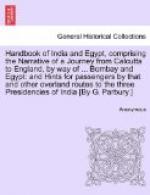Another noteworthy feature of the summit of the hill is a collection of stone cisterns of varying ages, still containing water. The smaller open cisterns, in which the water is thick and covered with slime, are of Musalman origin, but there are one or two in other parts of the hill which clearly date from Buddhist ages and are coeval with the rock-cells. The most important and interesting of all are four large reservoirs, supported on massive pillars and hewn out of the side of the hill, which date from about 1100 A.D., and were in all probability built by the Yadav dynasty of Deogiri. One of them known as Ganga and Jamna is full of clear cool water which, the people say, is excellent for drinking. Here again the hand of the vandal has not been idle; for such names as Gopal, Ramchandra, etc., are scrawled in English characters over the face of the chief reservoir— the holiday work no doubt of school-boys from Junnar. The presence of these four reservoirs, coupled with other disappearing clues, proves that between the Buddhist era and the date of the Musulman conquest, the hill must have been fortified and held by Hindu chieftains, probably the Yadavas already mentioned. The purely Musulman remains include the Ambarkhana, a prayer-wall or Idga, the skeleton of a mosque, with a delicate flying arch, and a domed tomb. In front of the prayer wall still stands the stone pulpit from which the moulvis of the fortress preached and intoned the daily prayers; but neither the prayer-wall nor the mosque have withstood the attacks of time as bravely as the tomb. For here scarce a stone has become displaced, and the four pointed arches which rise upwards to the circular dome are as unblemished as on the day when the builder gazed upon his finished work and found it good. The Gazetteer speaks of it as a man’s tomb; but the flat burial-slab within the arches points to it being a woman’s grave; and local tradition declares that it is the body of the mother of one Daulat Khan which lies here. Had those she left behind sought to bring peace to her dust, they could have chosen no more fitting site for her entombment. For each face of the grave commands a wide prospect of mountain and valley, the massive hills rising tier after tier in the distance until they are but faint shadows on the horizon; the intense solitude peculiar to mountain-country is broken but fitfully by the wild-dove’s lamentation; and even when the sun in mid-heaven beats down fiercely upon the grassy barrows of the hill top, the breeze blows chill through the open arches and the dome casts a deep shadow over all.




